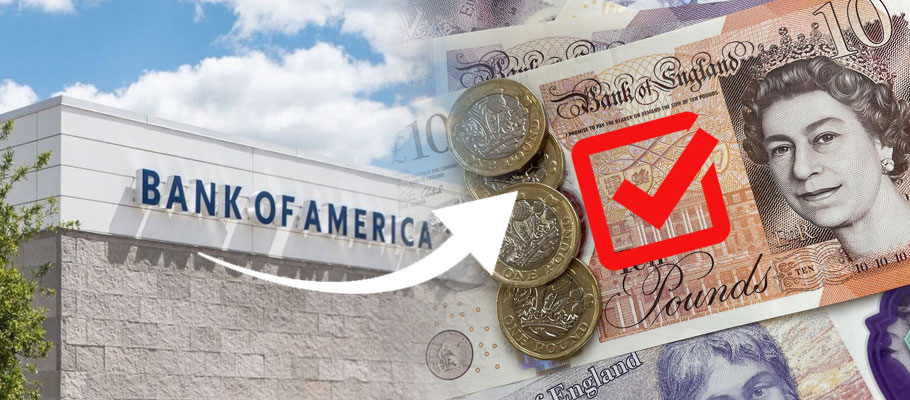
Published: November 22nd, 2023
Forex analysts at Bank of America say Sterling is looking like its old self again after years of volatility, and has likely moved beyond its lows. In an analyst note published this week, the bank’s FX Strategy unit said GBP had ‘fully returned to the G10 fold’ after an extended risk premium caused by negatives like Brexit and the errors of the brief Liz Truss period in Westminster.
A ‘sense of normality has returned’, the bank says, which significantly reduces downside risks.
The note explains that a number of novel factors decoupled GBP from its traditional moorings. The most recent was the incoming Truss government’s disastrous mini budget in September 2022, which frightened investors to such an extent that it caused a plunge in Sterling’s value, even as British bond yields rocketed higher.
Under normal circumstances, rising yields would have led to a rising Pound. The divergence confirmed that Sterling had unhinged from its traditional drivers. Much of this year, the bank notes, has been marked by GBP strength that tracked higher in tandem with UK bond yields.
BoA analysts say September 2022 marked the high point for market stress on UK assets.
Previous BoA commentary, particularly following the Brexit referendum, had sometimes compared Sterling to an emerging market currency thanks to its un-coupling from factors that normally defined its price action.
This year has seen forex traders 'price out' a risk premium from GBP, which has pulled it back into the G10 fold.
‘Sterling has been a relatively uncomplicated currency to analyse in the past,’ the bank says. 'The Pound has traditionally been guided by the global risk and global rates cycles’.
In late August the Pound dipped below a benchmark level of technical support against the Greenback, its top G10 peer, and was battling to stay afloat against the Euro after global investors adopted a risk-off approach. The change in sentiment looks to have been triggered by a rally in government bond yields, which deepened the losses for Sterling.
In the last week of August, GBP dropped under 1.26 against USD for the first time since early June, posting deeper losses in Asia that carried over to the European trading session as investors looked ahead to remarks from the Federal Reserve.
A market commentary by RBC Capital Markets said that the Dollar had been ‘buoyed’ by rising American interest rates that pushed the DXY (Dollar comparison) Index north of 104.
‘The market for swaps is pricing in a better-than-even chance of a new Fed rate hike announcement during the November FOMC meeting. The probability of this happening has been rising incrementally since this week’s session began.’
Sterling had been supported well between 1.261 and roughly 1.2631 since early June, RBC analysts said, but the level surrendered to risk-off sentiment between Tuesday's close of trading in London and New York.
The losses seen this week added to declines seen the previous week (w/c 21st August) when S&P Global PMI surveys warned that recession-like conditions were rising in Britain’s services and manufacturing sectors.
‘The figures expressed in the most recent business surveys point to a UK economy that’s slowly running out of steam,’ said analysts at Oxford Economics in an interview with Bloomberg. 'As composite PMI's have fallen sharply into contractionary territory, investors need to be concerned about the trajectory.’
In May, GBP gave back recent gains against USD and EUR following publication of UK wage and employment data that indicated Britain’s labour market may have reached an inflexion point.
According to the UK Office of National Statistics (ONS), average UK earnings rose by 6.6 per cent in March, slightly less than the 6.7 per cent figure consensus had expected, but still a shade above April's 6.5 per cent.
With bonuses factored in, the figure was 5.9 per cent, which was anticipated, and held steady at the previous month’s level.
Bank of England (BoE) policymakers have been focused on wage data throughout 2023 as they watched for signals that UK inflation was intensifying. While the numbers were robust, Threadneedle Street has been inclined to underplay the impact of wage increases, believing they would be mitigated in time by rising unemployment.
Alongside the wage rise, Britain’s unemployment rate increased to 3.8 per cent in March. Consensus had expected unemployment to remain unchanged at the previous month’s 3.7 per cent.
The data may signal that the hot UK labour market may finally be starting to cool, potentially giving the Bank of England breathing space to look again at concluding the current interest rate hiking cycle.
The Pound was unsurprisingly softer in the wake of the data release. The Pound to Dollar rate dropped 0.30 per cent in the 30 minutes following the release to 1.2474. The Pound to Euro rate fell 0.20 per cent in the same period, dropping to 1.1479.
In January, data from the final quarter of 2022 showed that Britain’s economy generated more jobs than anticipated, alongside faster-than-anticipated wage growth. Forex traders were surprised by the labour market growth and began to price in another interest rate hike.
Sterling rose after an additional 27K jobs were generated in the three months to 31st December 2022. That projection was unchanged from the previous month, but consensus believed a slowdown to 5K new jobs was in the works.
Unemployment was unaffected, holding firm at 3.6 per cent. People signing on for unemployment benefits rose by 19.6K, less than the 19.7K markets were expecting.
Average earnings including bonuses grew by 6.3 per cent, a rise from October's 6.1 per cent and beating expectations that a 6.2 per cent print would emerge. Take bonuses away and the rate of wage growth rises slightly to 6.4 per cent.